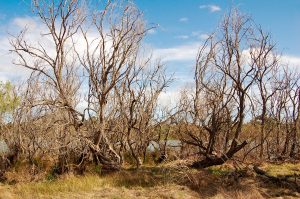Drought can impact trees for years to come
Chronicle Media — August 21, 2016
Young trees and shrubs are impacted first because they often do not have well established root systems. When a drought occurs, their leaves lose more water than the root system can supply and leaf scorch usually occurs. In this situation, the leaves may turn brown starting at the edges and between the veins of the leaf. Photo by CSIRO
Many people feel that large old trees won’t be harmed by drought because they have large root systems. This is not the case.
Many of these are just now showing symptoms from the severe drought of 2012. Major weather events have a detrimental long term effect on landscape plants.
Instead we often see substantial tree dieback and death due to the drought over the next several years. The tree continues to use up its reserves, and is not able to fully recover water and nutrients needed for long-term growth.
Many trees will take three years to die, and some will hang on until five years after the drought. As these trees decline, they are more susceptible to insect and disease infestations.
Unfortunately, there is very little that can be done to save many of these old trees. Some arborists are finding initial success using a growth regulator treatment. The growth regulator slows the tree’s output of new growth and fruit production, thus reverting its energy production back to its reserves, which are so severely depleted from major weather events the past three to five years.
Regrettably, this is a very expensive treatment without sufficient data to prove its long-term effectiveness.
Plan ahead to prevent this problem in the future. If rain does not occur for a 3-week period, consider watering trees and shrubs once a week until rains resume. A heavy complete watering is more effective than shallow watering. Shallow watering will encourage shallow rooting which can lead to root damage during a severe drought.
Young trees and shrubs are impacted first because they often do not have well established root systems. When a drought occurs, their leaves lose more water than the root system can supply and leaf scorch usually occurs. In this situation, the leaves may turn brown starting at the edges and between the veins of the leaf.
If lack of water continues, the leaves and shoots begin to wilt. The plants at this point may drop large numbers of leaves because the plant cannot continue to maintain them. You may even note early fall coloration of the leaves due to this water stress.
Evergreen plants may suddenly turn brown resulting in the loss of the plant.
University of Illinois Extension has more information on dealing with drought in the home and garden at http://web.extension.illinois.edu/drought/homegarden.cfm.
Rhonda J. Ferree, Extension Educator, Horticulture, ferreer@illinois.edu
— Drought can impact trees for years to come —







